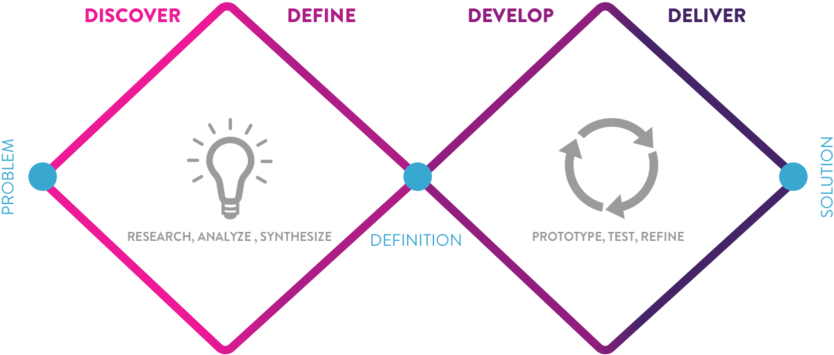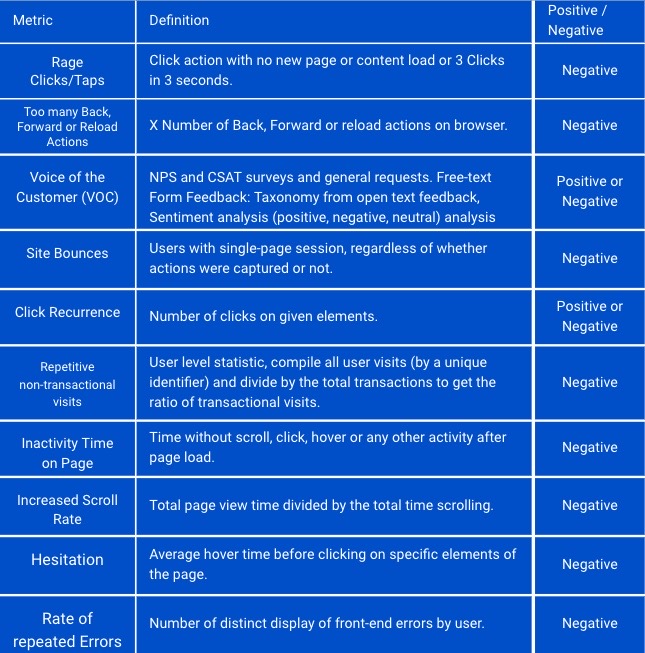When talking about sentiment in the digital realm, most people refer back to NPS or CSAT scores. But according to studies, the percentage of users who leave feedback after a positive experience ranges from 1% to 10%, while the percentage of users who have a bad experience and leave a comment is around 20%. Taking this into consideration, you could be missing out on the true and unbiased digital sentiment of around 70% of your users!

What sentiment signals should I look for?
- Rage Clicks/Taps: This is the most common form of frustration or anger from a user. Every solution has a slightly different definition of ‘rage clicks/taps,’ with some categorizing it as the sum of clicks/taps within a certain time frame (for example, 3 clicks/taps in 3 seconds), while others approach it in a more programmatic way (for example, the user clicks multiple times on any given element on the site, but it does not produce a new event such as a page change, content change, or visual change on the browser).
- Too many Back, Forward & Reload actions: This can occur when the user is trying to find the information they need, but they keep getting redirected to other pages, or when the site is slow to load and the user has to constantly refresh the page. Website designers should consider the user experience and make sure the site is easy to navigate, loads quickly, and provides the information that users are looking for in a clear and concise manner. Additionally, a well-designed search function can help users quickly find what they need, reducing the need for back and forward actions.
- Voice of the Customer (VOC): This is one of the most direct but complex ways to evaluate your customer’s sentiment. Let’s look into the different ways you can use their voice to your advantage.
- Score based feedback: NPS and CSAT are the perfect example of a score used to determine if users are satisfied with the online service provided by your site, or not.
- Free text form feedback: This is where users take the time to share their thoughts on the experience they had on your site. Surveys (online or paper-based), social media, customer service calls, online reviews, focus groups, and even employee feedback are full of valuable information that can help you improve the experience on your digital properties. Mine them!
- Site bounces: The definition of bounces varies in different digital analytics solutions, but what really matters is that it applies to your specific use case. A high bounce rate can indicate a poor user experience, which can negatively impact a website’s engagement and conversion rate.
- Click Recurrence: Unlike “Rage Clicks/Taps,” click recurrence is defined as the total or average of clicks on certain content. This can be a sign that users are having trouble finding the information they need, making them less engaged and leading to increased bounce rates.
- Repetitive non-transactional visits: Make sure your site has a clear and intuitive navigation structure that makes it easy for users to find what they’re looking for. Consider adding search functionality and clear categories to help users find the information they need.
- Inactivity time on page: This behavior can indicate that the user is not finding the information they need, or that the page is not holding their attention.
- Increased scroll rate: A high scroll rate can indicate that a user is engaged with the content on a page, that the information on the page is not clearly organized, or that the user is having trouble finding what they’re looking for. In these cases, it may be necessary to make changes to the content or layout of the page to improve the user experience.
- Hesitation: Users who land on your site and are exploring your products are usually very interactive, but what about those who spend a lot of time without taking specific actions? Track the elements on a page that have a high hover
- Rate of repeated errors: If while navigating you receive an error message, that might not be that bad, but have you ever gotten the same message over and over again without knowing what you did wrong? Remember to clearly display the reason and possible solution to an error presented to the user.
Your site is a living organism, your solutions have to learn and evolve

Applying the Double Diamond Design process can ensure that solutions to the problem of bad sentiment in online experiences are relevant and effective. The four phases of the process include Discovery, Define, Development, and Delivery.
In the Discovery Phase, research is conducted to identify the sentiment signals in the online experience
The Define phase, involves defining the problem through the creation of user personas, empathy maps, and a shared understanding of the problem.
The Development phase, involves developing and testing prototypes of your sentiment score to address the problem through usability testing, A/B testing, and iteration based on user feedback. Here is where you will apply different weights to each individual signal to determine which ones have more impact in the user experience.
The final Delivery phase, involves launching the solution, with a focus on prioritizing the user’s needs and being flexible to feedback and iteration.
It’s important to keep the user’s perspective in mind throughout the process to ensure a positive online experience that effectively addresses frustration.”
Regulations to protect users in distress
In countries like the UK, there are regulations in place for financial institutions to support users who present signs of distress while applying for a loan online. These regulations aim to ensure that consumers are not subject of unreasonable or excessive stress during the application process.
One of the key regulations requires financial institutions to assess the state of mind of a customer before granting a loan. This assessment must take into account various factors of the customer’s online interactions such as repeatedly filling out forms, constantly changing information, inaccuracies in the data provided compared to address verification systems, and others.
This regulatory framework is designed to protect consumers in distress by ensuring that financial institutions consider their circumstances and provide appropriate support.
Feel free to reach out if you have questions about how to implement this solution!
Addendum
Sentiment Signals & Metrics

